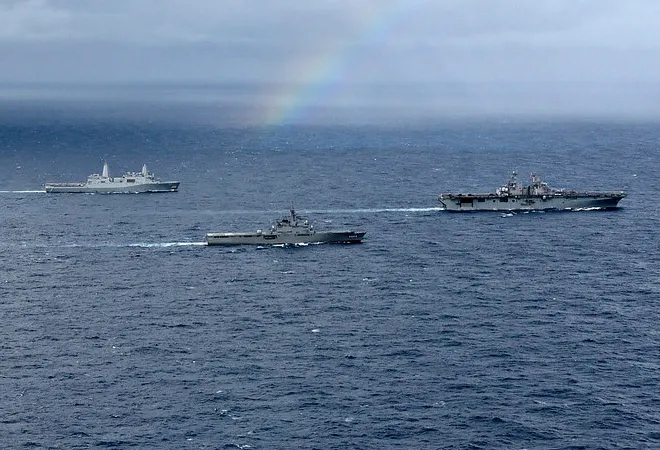
With a huge market and the busiest maritime shipping lanes, the Indo-Pacific houses aspiring economies alongside other countries outside the region who have a stake in the peace and stability of the Indo-Pacific. It is no wonder, therefore, that various combinations of bilateral, mini-lateral, and multi-lateral cooperation forums have sprung up in alignment with common interests and concerns. With this rose a demand for countries like Japan, Australia, and also India to assume a greater visibility and engagement and, in doing so, to also offer alternative sources of collaboration to countries who have remained heavily reliant on China. In this context, the evolving role of India—which had been steadily growing in recent years—calls for understanding and assessment as the pandemic has arguably accelerated the pace of India’s participation in the Indo-Pacific.
The decade beginning from 2020 was already set to witness an intensification of the global systemic rivalry with the international rules-based system which administered global interactions in the post-World War II period coming under threat with the steady rise of China as hegemonic pole with influence and leverage across the length and breadth of the Asian continent and over the world at large. The arrival of arguably the most challenging global health crisis ever has pushed the world into unanticipated uncertainties while simultaneously accelerating and recalibrating global exchanges. Since the beginning of 2020, therefore, the COVID-19 pandemic has exposed and exacerbated fault lines in an Indo-Pacific already fraught with competing as well as cooperative geopolitical equations with regional and global actors being called upon to reign in the ensuing disruptions and establish alternate response mechanisms.
As the Indo-Pacific construct gains momentum, so has acknowledgment by New Delhi of investing in resources and policy frameworks that are geared towards expanding India’s engagement with the region. The country’s regional policy is, hence, now informed by a more constructive maritime policy and an augmented role assumed by the navy, together with the fostering of ties with partners of congruent interests. The disruptions caused by the pandemic and India’s response to the same have resulted in augmenting the country’s position and involvement in the Indo-Pacific region.
The COVID-19 pandemic has exposed and exacerbated fault lines in an Indo-Pacific already fraught with competing as well as cooperative geopolitical equations with regional and global actors being called upon to reign in the ensuing disruptions and establish alternate response mechanisms.
China’s efforts at building continental as well as maritime channels are aimed at binding countries around the Bay of Bengal and the Indian Ocean closer with the Chinese economy and to establish trade routes allowing Beijing access to the Indo-Pacific, Europe, and Africa. While China has been carrying out its objectives, it is important to note that India too has been focusing on stimulating its engagements with the neighbourhood and strengthening networks with middle powers in the region like Japan and Australia alongside deepening its engagement with the US. India acknowledges that it cannot match China’s deep pockets but it does have close civilisational and cultural ties with its neighbourhood which is an asset that China does not possess (Mullen and Poplin, 2015).
Nevertheless, the Indo-Pacific perhaps is an inevitability—a geo-economic reality providing a context within which China has been rising—but not an outcome of China’s rise as it is often touted to be. Hence, collaborations and intensification of intra as well as extra-regional interdependencies are also natural consequences. While countries like Japan, Singapore, and Australia have been players—albeit with varying degrees of vigour—the expansion of India’s capacity and intent to assume a more active role in many ways corresponds with the rise in prominence of the Indo-Pacific.
The strengthening of the India–US strategic partnership, for instance, mainly through defence ties, acts as a strong counterweight to India’s regional rivals. Enhanced engagement with the US has taken place in the backdrop of rising Chinese naval adventurism in the South China Sea and also in the Indian Ocean Region. Besides the maritime domain, India also began to step up its engagements with the larger Eastern and Southeast Asian region since 2014 under the aegis of the refurbished Act East Initiative and the Neighbourhood First Policy and SAGAR (Security and Growth for All in the Region) which has been more focused on the maritime domain. The country has signalled its interest and displayed its intent in enhancing its partnership with not only countries like Vietnam, Indonesia, Australia, and Japan but also with regional institutions like ASEAN with a renewed eastward focus. This has been a clear departure from its earlier diffidence and inability to integrate itself with the larger Eastern neighbourhood.
India acknowledges that it cannot match China’s deep pockets but it does have close civilisational and cultural ties with its neighbourhood which is an asset that China does not possess (Mullen and Poplin, 2015).
The close friendship shared between Tokyo and New Delhi and the congruence in their policy approaches towards the region have made both natural partners. Together, the two countries are not only members of regional intuitions, but have also expressed intent in and begun to collaborate for the development of infrastructure projects in third countries across the region. India has reciprocated Taipei’s overtures under the latter’s New Southbound Policy by signalling its intent to elevate relations with Taiwan in sectors like trade, investment, education, and tourism. Mention must also be made about the significant role played by Taipei, especially in the context of the COVID-19 pandemic. Similarly, Korea’s ‘New Southern Policy’ has distinct policy convergences with New Delhi’s Act East Policy alongside common ground with the broad framework of a Free and Open Indo-Pacific. India’s strategic role is further boosted under India–Australia relations, which were upgraded as part of the Comprehensive Strategic Partnership in 2020. In a similar vein, India has been making concerted efforts in the African continent too.
India has emerged not only as an active and willing player in the Indo-Pacific region but also as a responsible actor from ramping up its capacities in supplying pharmaceuticals to transforming its manufacturing base to cover key essentials required by the health sector to supplying medical aid to several countries. Alongside these, the Quad has turned out to be one of the key platforms which has witnessed the expansion of India’s role in the Indo-Pacific during the ongoing pandemic. The positive role assumed by India sends a vital signal regarding its political intent to participate in the region in keeping with its capacities. In some ways, New Delhi’s prompt and proactive approach is a culmination of the deepening of its strategic ties with the US, Japan, Australia, and ASEAN alongside the concurrent strengthening of the involvement of these countries within the region as well.
There are many lessons to be drawn from the pandemic, the most vital of which is possibly the urgent need for concerted action and the merit in building resilience—across sectors, services and strategies. Indeed, longer term impacts of the pandemic will be determined to a large extent by the policy responses and adaptations undertaken by governments because while the pandemic is a global health crisis, its impacts encompass all walks of life and are set to constitute far-reaching consequences for years to come. In this context, India’s position as a direct stakeholder in the region gives New Delhi the edge to initiate dialogues as well as assist in the creation of a balanced security architecture to deal with traditional and non-traditional security issues.
(This is a summary of the article - India in the Indo-Pacific: China, COVID-19 and the Reconfigured Regional Order published in the Journal of Indian and Asian Studies, Vol. 2, No. 2. July 2021)
The views expressed above belong to the author(s). ORF research and analyses now available on Telegram! Click here to access our curated content — blogs, longforms and interviews.




 PREV
PREV



